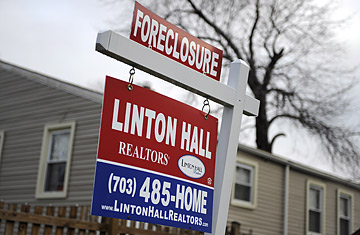
A foreclosure sign is posted in the front of a house in Alexandria, Virginia.
The Obama administration wants to spend up to $100 billion on efforts to help homeowners, especially those facing foreclosure. But one of the leading ideas on how to do that — rewriting home loans to make mortgages affordable to struggling borrowers — is based on a startling lack of data about what works, and early evidence suggests that many lenders aren't going to make substantial changes without serious strong-arming.
There are various ideas being bandied about, but the goal is common: to entice mortgages servicers, whether lenders themselves or third parties acting on behalf of investors, to rewrite the terms of loans so that people behind on payments might be able to keep their homes. (Read the four steps to ending the foreclosure crisis.)
One way being discussed to do that is for the government to share in the losses if a servicer modifies a mortgage and the homeowner again defaults. Another approach is to directly help pay for the cost of the modification. The servicer might cut monthly payments to 38% of a borrower's income with the government chipping in to reduce the payment down to 31%, a presumably more sustainable level. Either tactic could be combined with a direct payment — $1,000 is a figure often mentioned — to incentivize servicers to do the heavy lifting of figuring out how much a homeowner can truly afford and recrafting his mortgage to match.
To a homeowner who has always made mortgage payments on time, perhaps by sacrificing spending elsewhere, the whole concept may seem grossly unfair. But society's problems are unfortunately often our own. As the foreclosure rate has skyrocketed, and loan defaults have rippled from subprime mortgages into ones made to prime and near-prime borrowers, property values in many parts of the country have been pounded. There is an unavoidable correction going on in house prices, that much is true, but the swoon has caused additional problems as it traps many flailing borrowers in their homes. Simply selling your home when you can no longer afford it is often not an option at a time when some 18% of mortgage holders owe more than their house is worth.
In July, Congress tried to address the underlying problem by creating Hope for Homeowners. It's a program meant to get people behind on their payments to refinance into more affordable loans. So far, the effort has gone practically nowhere. While tens of thousands of homeowners have called to ask questions, the program has only received 451 applications and closed 25 loans. That's partly because of the program's high barriers — homeowners have to get their existing lenders to write down the value of what they're owed and then find a new lender to issue a fresh loan. Most major banks haven't signed up to participate. On Feb. 3, the House Financial Services committee held a hearing on how to revamp the program.
In the meantime, the discussion has turned to ways to encourage lenders and servicers to modify their own loans. Most, if not all, firms are already doing this, and some, such as JP Morgan Chase, have announced major new efforts, since it is generally in a lender's best interest to keep borrowers in their homes, even if they're paying less. Foreclosure is such a costly process, a lender might easily only recoup half of what it's owed. In August, the Federal Deposit Insurance Corporation instituted an aggressive loan-modification effort at the failed IndyMac Bank, and that program is now a template for what the government might encourage at a national level. Basically, the FDIC wants to set up a series of incentives, like $1,000 for each modification, as well as loss sharing, should rewritten loans run into trouble.
